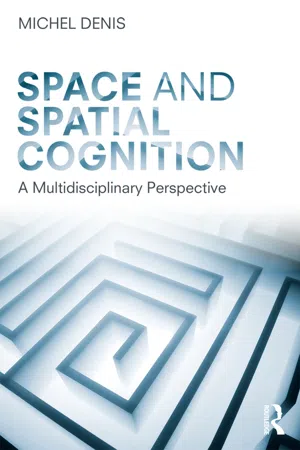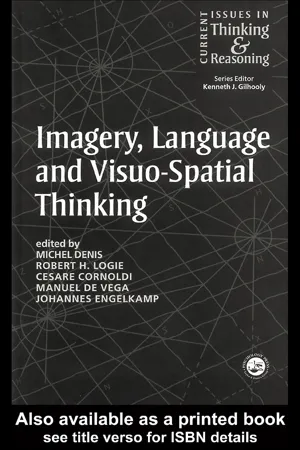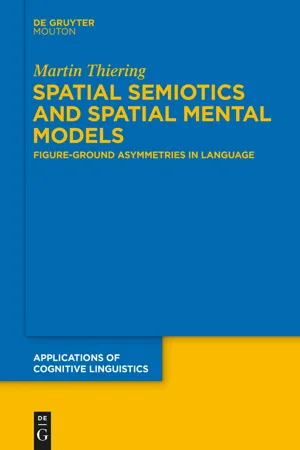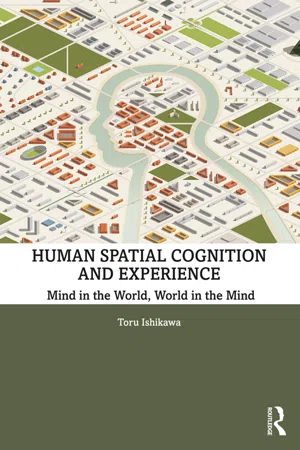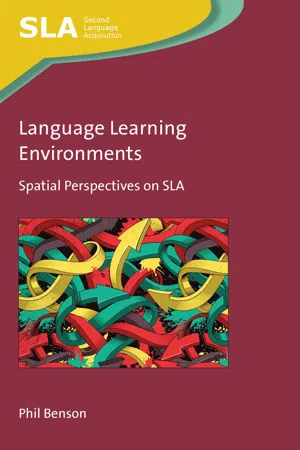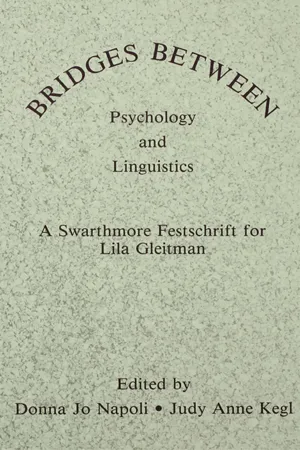Languages & Linguistics
Spatial Description
Spatial description refers to the linguistic expression of spatial relationships and locations. It encompasses the vocabulary, grammar, and discourse strategies used to convey information about the physical arrangement of objects and entities in space. This can include the use of prepositions, adverbs, and other linguistic markers to indicate direction, proximity, and relative position.
Written by Perlego with AI-assistance
Related key terms
Related key terms
1 of 4
Related key terms
1 of 3
9 Key excerpts on "Spatial Description"
- eBook - ePub
Space and Spatial Cognition
A Multidisciplinary Perspective
- Michel Denis(Author)
- 2017(Publication Date)
- Routledge(Publisher)
Beyond the arguments provided by comparative psycholinguistics, interfacing between spatial language and the expression of spatial knowledge and capacities is attested by developmental studies. For instance, it is well established that children whose parents make use of large amounts of spatial vocabulary have linguistic productions that are richer in spatial terms than children of the same age less exposed to spatial terminology. Still more remarkably, these children are more likely to perform better at a later age in tasks requiring good control of visuo-spatial capacities, such as figure transformations or discovery of spatial analogies (see Pruden, Levine, & Huttenlocher, 2011). In complement to sensorimotor experience, spatial language does contribute to improving the quality of people’s spatial thinking.Passage contains an image p.132 11 Spatial DescriptionS
It is classic to point to the contrast between the multidimensional structure of space and the unidimensional organization of language. Whereas spatial objects are distributed over at least two dimensions, it is inherent to language to convey information in successive pieces, according to sequences governed by a set of syntactic rules. By construction, the full set of statements that are combined to verbally account for a situation can only be delivered sequentially. This constraint obliges the speaker to decide the order in which the components of a linguistic message will be stated and thus communicated to an interpreting agent. This is true of every subject of discourse, but in the case of space, a set of particular decisions will have to be made with the objective of finding a sequence that gives the addressee the possibility of building a coherent and informationally valid representation.To start with, from which point of a configuration, from which object in a scene should a description be initiated? Then, which further object should be posited by reference to the first one, and so on? For even a small set of objects that compose a scene, there is a huge number of theoretically possible sequentializations. This situation creates a challenge for the art of description, although it soon appears that a narrower set of options is eventually retained by speakers/writers. Which factors constrain describers to finally converge on a limited number of descriptive sequences?To describe a scene is not a self-evident exercise. The activity is likened to the resolution of the so-called “ill-defined” problems, that is, problems which do not allow for a single solution, but several possible ones. These solutions, in the case of Spatial Descriptions, can be hierarchized and classified as “more or less” adequate in terms of clarity and communicative value. Will we identify some descriptive sequences as more sound than others to communicate information and optimize the chances of an addressee acquiring new knowledge in good cognitive conditions? - eBook - ePub
- Michel Denis, Robert Logie, Cesare Cornoldo, Manuel de Vega, Johannes EngelKamp(Authors)
- 2012(Publication Date)
- Psychology Press(Publisher)
CHAPTER FIVE The interface between language and visuo-spatial representationsManuel de VegaUniversidad de La Laguna, Tenerife, Canary IslandsMarguerite Cocude and Michel DenisLIMSI-CNRS, Université de Paris-Sud, Orsay, FranceMaria José RodrigoUniversidad de La Laguna, Tenerife, Canary IslandsHubert D. ZimmerUniversität des Saarlandes, Saarbrücken GermanyINTRODUCTIONSome animals develop a sophisticated spatial knowledge necessary for way-finding, migrating, establishing the boundaries of their territory, nesting and so on. However, only humans are able to share their spatial knowledge by using language to communicate. This chapter addresses the issue of spatial communication with a focus on the mental representations that underlie our locative expressions and, more generally, spatial discourse. All languages have a rich vocabulary of locative terms that cover several linguistic categories. For instance, in English and in most Indo-European languages there are spatial adverbials (e.g., “here”, “there”, “behind”, “below”), prepositions (e.g., “in”, “on”, “from”, “near”), adjectives (e.g., “big”, “short”, “large”), pronouns (e.g., “this”, “that”), nouns (e.g., “circle”, “square”, “triangle”), and verbs (e.g., “to enter”, “to leave”, “to jump”, “to cross”, “to support”, “to contain”). Some of these locatives are particularly important because they are closed-class words (e.g., prepositions) or, in some languages like German, morphological flexions (case affixes) that convey spatial meaning. Closed-class words and morphological flexions correspond to concepts incorporated into the grammar of a language, and their use is frequently mandatory in sentences. Only a few concepts enter the closed-class category of words or become grammaticalised. Thus, in many languages, time, person, quantity, or gender are incorporated into the grammar. Some spatial concepts also belong to this privileged “club” although their use in each sentence is generally optional rather than mandatory (unlike other concepts such as time incorporated in verb tenses, or quantity implicit in number morphemes). - eBook - ePub
Representation, Memory, and Development
Essays in Honor of Jean Mandler
- Nancy L. Stein, Patricia J. Bauer, Mitchell Rabinowitz, George Mandler(Authors)
- 2014(Publication Date)
- Psychology Press(Publisher)
Rather, linguistic categories appear to be constructed in part by the semantic conventions of particular languages. Thus, language is accorded a certain freedom of action in its organization of the world around us. However, it is also possible that there are broad universal tendencies underlying this variation. Specifically, there may be culturally-invariant aspects of perception and cognition that leave their imprint on language (Clark, 1973; Kay & McDaniel, 1978; Mandler, 1992, 1996). Such a perceptual core would constrain the semantic partitions that an individual language may make. At the same time, within these constraints, the specifics of a given language may also contribute to the shaping of meaning (Regier, 1996). FIG. 12.1 Mixtec and English spatial terms. The linguistic expression of spatial relations is a particularly useful domain in which to explore these issues of cognitive constraint in language. There are three converging reasons for such a focus on space in particular. The first is that languages differ in their structurings of space (Casad & Langacker, 1985; Levinson, 1996; Talmy, 1983). An example is the Mixtec/English difference, shown in Fig. 12.1. Thus, we may be assured that the cross-linguistic variation that motivates this inquiry is represented in the spatial domain. The second reason is that spatial cognition is a foundational element of human understanding. Certainly, prelinguistic children demonstrate some very early spatial competence (Bomba, 1984; Needham & Baillargeon, 1993; Spelke, Breinlinger, Macomber, & Jacobson, 1992), and this spatial understanding later undergirds some aspects of nonspatial cognition as well (Lakoff, 1987; Mandler, 1992, 1996) - eBook - ePub
- Martin Thiering(Author)
- 2014(Publication Date)
- De Gruyter Mouton(Publisher)
The issue here is the various degrees of specificity speakers assign to different figure-ground asymmetries. Results from a visually based elicitation procedure indicate differences in the encoding of spatial topological relations between speakers and between languages. As such, this research echoes numerous studies on language variation in spatial semantics as known from typological and cognitive semantic approaches. The different degrees of specificity result from different practices chosen by speakers. The data supports the idea that linguistic meaning reflects degrees of specificity of social practices or language games.The linguistic phenomenon known as degree of specificity of the figure’s location in relation to the ground refers to the amount of detailed expressive content with which spatial relations are described in various languages (Svorou 1993). This chapter subscribes to the idea that “linguistic meaning is inextricable from the social practices (language games) in which language is used” (Zlatev 1997: 5; “language games” is adapted from the later Wittgenstein and highlights the pragmatic function of language and meaning; see Wittgenstein 2006). It is interesting that speakers choose to encode the same situation in very different ways (i.e., use different degrees of specificity). This is not only the case between languages (interlingual), but also within a single language (intralingual).Results from the visually based elicitation tool offer insights into the spatial topological semantics of the two languages . As outlined above, the Topological Relations Markers series of 71 simple black and white drawings was used to elicit the usage of spatial language (Pederson, Wilkins and Bowerman 1998).78 - eBook - ePub
Human Spatial Cognition and Experience
Mind in the World, World in the Mind
- Toru Ishikawa(Author)
- 2020(Publication Date)
- Routledge(Publisher)
Chapter 7Communicating information about spaceThe foregoing chapters mainly dealt with internal representations of the environment; that is, what is contained in the knowledge about the environment and how it is represented in the human mind. This chapter focuses on external representations of the environment, namely expressions of the knowledge about the environment in words or as visual representations, particularly in the context of communicating knowledge about surrounding environments to other people and assisting people in navigation and wayfinding. The first section looks at spatial language as a medium of communicating knowledge about space—verbal descriptions or navigational directions—by clarifying the concept of spatial frames of reference as it pertains to the conceptualization of space. The second section discusses the understanding and use of maps, a major medium of geographic knowledge since antiquity, particularly the characteristics and potential difficulty of spatial orientation with maps in the environment. The third section discusses recent technologies of navigation assistance, or satellite navigation systems and applications, and the characteristics of spatial behavior by users of such advanced geospatial tools.Spatial languageSpatial frames of reference
When you are asked directions to the nearest restroom, you say, “Go down the hall and make a right, then you will see it on your left.” When you tell your partner where you are waiting at the airport, you say on the cellphone, “I am in the North Terminal, standing in front of a cafe on the second floor.” When you give directions to a taxi driver, you say, “Go down south on Smith Avenue and take the freeway up to Turnpike; the third house after the exit is my place.” To describe where you are, where an object is, and where a place is, you need to specify the location of yourself, the object, and the place. How do you specify the location, then?—you do so in relation to “something” in space. The something may be a person (e.g., on your left), a concrete object (e.g., in front of a cafe), or an abstract framework imposed onto the environment such as cardinal directions (e.g., down south) or latitude and longitude (e.g., you say “see you at 35° 42′ north and 139° 45′ east tomorrow,” if appropriate). In essence, this is a process of describing “where something is with respect to something else” (Levinson, 1996, p. 110). The way in which the something and something else are related constitutes a system of spatial localization, called a frame of reference - eBook - ePub
Language Learning Environments
Spatial Perspectives on SLA
- Phil Benson(Author)
- 2021(Publication Date)
- Multilingual Matters(Publisher)
Chomskyan linguists have spatialised grammar to an extraordinary degree, beginning with Chomsky’s ‘transformations’, which are essentially spatial rearrangements of the grammatical components of written sentences, although they are assumed to take place deep within the mind. Lantolf (1996: 727) noted a list of terms used by Chomskyan linguists, including ‘dominance’, ‘command’, ‘government’, ‘binding’, ‘subjacency’, ‘barriers’, ‘constraints’, ‘dependency’ and ‘chains’. For Lantolf, these were ‘conceptual metaphors of power and control’. They are also metaphors of space that illustrate the dependency of modern linguistics on spatial representations of language. Halliday (2003) is a retrospective overview of his key ideas on language titled ‘On the “Architecture” of Human Language’. The inverted commas around ‘architecture’ suggest that Halliday did not think that language was actually designed in the fashion of a building. Yet, there is ample evidence in the article of a highly spatialised lexicogrammar. Simple sign systems, Halliday (2003: 5) suggests, can be ‘expanded’ on four ‘dimensions’: they can be ‘combined’, ‘uncoupled’, ‘layered’ or ‘networked’. The systems that make up networks of choice are described as ‘organizational spaces’, and lexical items are described as occupying ‘the more delicate regions of one continuous lexicogrammatical space’. The evolutionary development from protolanguage to language, in which language lost its dependence on the ecosocial environment, is described in explicitly spatial terms: ‘a space was created in which meanings could be organised in their own terms, as a purely abstract network of interrelations’ (Halliday, 2003: 14) - eBook - ePub
- Wolfgang Klein(Author)
- 2018(Publication Date)
- De Gruyter Mouton(Publisher)
None of these conditions is trivial, neither for speaker and listener nor for the researcher who wants to analysis their functioning. Linguistic research tends to focus on the second task, the analysis of linguistic meaning proper, and to neglect the two others. In what follows, I shall briefly comment upon these conditions and try to show why no sensible analysis of spatial reference is possible without considering all of them.2.1Structure of space
The notion of space123 which underlies (1) and (2) is what one might call “normal perceptual space” – that kind of space which underlies our everyday perception and action, when we see this and that, hear this and that, move from here to there. Such a space is assumed to consist of smaller entities (“places”), for which a twofold structure is defined: There are three dimensions (vertical, horizontal, transversal, or up-down, left-right, front-back), and there are topological relations, i.e., a place can be (partly) contained in some other place or in the neighborhood of some place.124 It is this structure which is reflected in the meaning of spatial terms such as on vs. under, beneath above, in vs. out, near, around, left vs. right , etc. But it is easy to see that not all usages of spatial terms operate with this type of space. I give some simple examples:(3) a. Sparta is in Greece. b. Sparta is on the Peloponnes. c. Sparta is not on the map. d. I can’t get this idea out of my head. e. I can’t get this idea out of my mind. f. I can’t get this girl out of my head. Would we say that Sparta is in the same way contained in Greece as, say, the coffee is contained in the cup? In other words, does geographical space have the same structure as immediate perceptual space? Probably not: We would not assume that Greece is in the same way a three-dimensional entity as, for example, a cup. Why do we say then that Sparta is on the Peloponnes – surely no less and no more a three-dimensional entity than Greece? Or are these different notions of Sparta, a two-dimensional and a three-dimensional one? Such a possibility is supported by usages like in (3c): Here, we are talking about a two-dimensional representation of Sparta on a two-dimensional map. Hence, the underlying space is somehow a conceptual reduction of “real” three-dimensional space. But if this is true, why does one then say on , as in (1)? Is the idea in (3d) a three-dimensional entity, contained in another three-dimensional entity head ? This seems possible for the head, less so for the idea ? Ideas are generally not assumed to have a dimension, let alone three. But how is this in (3e), where neither idea nor mind are usually considered to have dimensions? But even if the entities at issue are normally understood to be three-dimensional, like girls, spatial relations can be stated between them which show that we often do not mean them to have three-dimensions, as is illustrated by (3f).125 - eBook - ePub
Bridges Between Psychology and Linguistics
A Swarthmore Festschrift for Lila Gleitman
- Donna Jo Napoli, Judy Anne Kegl, Judy Kegl, Donna Jo Napoli, Judy Anne Kegl, Judy Kegl(Authors)
- 2013(Publication Date)
- Psychology Press(Publisher)
A last point on the disparity between the expressive power of the two systems: Rueckl, Cave, and Kosslyn’s (1988) study involved a stimulus space containing only nine different shapes, each of which could occur in nine partially overlapping locations. Within this tiny system, it was found that the optimal allocation of resources between the “what” and “where” systems used over three times as many “what” units as “where” units. Although it is hard to know how this case generalizes to a more realistic system, the disparity is reminiscent of that found between the noun and the preposition system. However, Rueckl, Cave, and Kosslyn argue that the disparity can only increase as one moves to a more realistic system. Thus our conjecture of the Poverty of Spatial Representation is suggestively supported on computational grounds.3.4 Directions for Research
If our conjecture is correct, we have found a bifurcation in the expressive power of language that corresponds to a bifurcation in the functional and anatomical systems of the brain. This is, to our knowledge, the first time within cognitive science that a correlation has been made between a property of grammar and a property of a nonlinguistic part of the brain. What is exciting about this correlation is that, where previous studies have documented the tasks performed by the two systems, linguistic evidence can now provide a window on the actual forms of information the systems encode.This possibility has suggested two programs of research currently being conducted by one of us (B.L.). The first stems from the asymmetry of spatial relations. According to the linguistic evidence, a spatial relation defines a region in terms of a reference object; the figural object is then located in the region. The implication is that regions are in some sense psychologically real—that one can investigate their properties experimentally. Studies currently under way suggest that adults and children as young as 3 years old make systematic judgments that reveal highly structured regions surrounding reference objects. For example, when asked to make repeated judgments as to whether one object is near - eBook - ePub
Linguistic Relativity in SLA
Thinking for Speaking
- ZhaoHong Han, Teresa Cadierno(Authors)
- 2010(Publication Date)
- Multilingual Matters(Publisher)
The block is on the building). In a picture recognition task participants saw the original pictures, pictures displaying a stronger version of the spatial relation originally seen (e.g. a picture of a block properly on top of the roof rather than perched on the edge of it) or a weaker version of the spatial relation (e.g. a picture of a block to the right of the roof not in contact with it at all). Feist and Gentner found that participants falsely recognized the stronger version of the spatial relations, but only when the sentences at encoding included a spatial preposition, suggesting that spatial language interacted with perceptual information during encoding. This study provides the impetus for a more detailed examination of possible conceptual differences between Spanish and English vis-à-vis containment and support spatial relations.Spatial language learning and linguistic relativity
Taking the Feist and Gentner (2007) study as a starting point, we set out to test whether the manipulation of language during the encoding of a visual image may prime the false recognition of visual features that correspond with the linguistic features encoded previously. Studies with speakers in L1 were intended to establish an initial difference between L1 speakers of Spanish and English in order to provide a suitable baseline to then test L2 speakers of English and Spanish at varying levels of proficiency using a more online task than those used previously in the spatial domain. We expected that English L1 speakers, with their language distinguishing between support (on) and containment (in), would be more sensitive to changes in these spatial relations (as a function of the preposition used initially to describe the relation) than Spanish L1 speakers who have a single lexical item (en) for both of these spatial relations. Moreover, some researchers have claimed that learning a second language involves mapping between L1 and L2 (language transfer), while others have argued that the language to be learned structures spatial categories without interference from L1 (Carroll, 1997; Ellis, 2006; Ijaz, 1986; Jarvis & Odlin, 2000, amongst others). From this it follows that there could be potential conceptual change as a function of the language being learned. If a difference in perceptual judgments with regard to changes in linguistic descriptions
Index pages curate the most relevant extracts from our library of academic textbooks. They’ve been created using an in-house natural language model (NLM), each adding context and meaning to key research topics.
Explore more topic indexes
Explore more topic indexes
1 of 6
Explore more topic indexes
1 of 4
